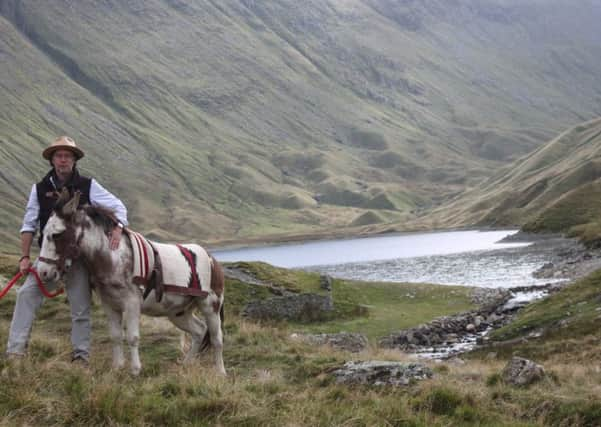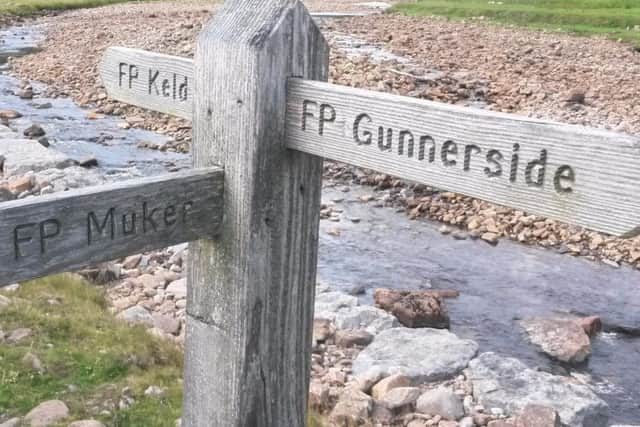My journey coast to coast with a mule


Trying to get a mule across Yorkshire is not as easy as you might think. Although this of course is once you have got past the stage of working out why you should try and do such a daft thing in the first place.
The idea had come about in the same focused way as so many of my projects: some long entertained half-thought (like trying to find an Inca ruin or running a black-market car from Texas to Central America) crystallising into action without at any stage being examined for plausibility, possibility or sheer bloody stupidity.
Advertisement
Hide AdAdvertisement
Hide AdAs my wife pointed out: “You haven’t really thought how you’re going to do this, have you?”


This was rhetorical, as married conversations often are. We both knew I hadn’t. I’d worked a lot with mules as pack animals in Peru and thought it would be intriguing to do the same along the rough route of the Coast-to-Coast, although obviously I would need to take bridleways not footpaths. So I found a mule called Jethro at an RSPCA rescue centre.
As soon as I met him, I could see Jethro had a bit of a spare tyre. If anything, this made me sympathetic. Just another middle-aged mule/male. Moreover, Jethro had been gelded late in life, so retained the energies and inclinations, if not the abilities, of a stallion.
He was small – about 12½ hands – with striking colouring, a freckling of white and beige like an appaloosa, and an enquiring and appraising gaze which I came to learn was characteristic.
Advertisement
Hide AdAdvertisement
Hide AdOur first meeting in the stable yard at the RSPCA was cordial, if not effusive; so English in the best possible sense. I noticed his eyes: dark, soulful and thoughtful.


His unusual colouring was not like anything I had seen in Peru, where mules tended to come either bay or skewbald.
Alice, one of his RSPCA carers, told me: “The thing about Jethro, is that he either likes you or he doesn’t”.
This seemed straightforward; and Jethro had so far showed no sign of taking against me. “The other thing is… he’s very intelligent. He’ll only do something if he wants.”
Advertisement
Hide AdAdvertisement
Hide AdAlice’s tone implied that Jethro’s intelligence was not always a helpful quality. She asked him where I was planning to take him. “Yorkshire.” “Oh, he’ll be fine then. It will be like taking him back to his spiritual home.”
By the time we entered Yorkshire at Nine Standards Rigg [having started in the Lake District] we were not exactly motoring but we had at least got over the early teething problems.
Jethro was eight, so a teenager in mule years, and I had discovered that he often began with great verve and enthusiasm which tailed off as he got bored. Which always happened around lunchtime.
His presence certainly sparked a great deal of conversation with those I met along the route. “Yes, we got plenty of mules around here as well,” one Swaledale sheep farmer told me.
Advertisement
Hide AdAdvertisement
Hide Ad“Really?” I was both intrigued and puzzled. Nobody seemed to breed mules in England and I haven’t seen a single one on my journey. The man laughed. “Mule sheep. Swaledale crossed with Blue-faced Leicester.”
I was determined to use the journey to talk to as many people living in the countryside as possible. By travelling at mule pace, I hoped this could be a discursive journey that chatted over gates to farmers and took in byways as well as highways.
Farmers come in all shapes and sizes in this country, from Michael Eavis to the Duke of Beaufort. Lumping them together is unhelpful.
And even less voice is usually given to the few farm workers who remain in an increasingly mechanised agricultural industry.
Advertisement
Hide AdAdvertisement
Hide AdI wanted to unpick the threads of what was really happening in the rapidly changing countryside, far from London and the metropolitan conversation.
I began to feel that a disconnect now reigns in the North, just as it does in the rest of the country.
The way in which so many of the middle-class are unaware of the depths of the pockets of deprivation, both in the countryside – where they are particularly easy to ignore – and in the small market towns that I passed like Richmond.
For I soon discovered that, along with its Georgian charm and impossibly picturesque position, as painted by Turner, there was a darker side to Richmond. The lamps along the castle walkway had been vandalised.
Advertisement
Hide AdAdvertisement
Hide AdLocals told me about a epic pub fight with some 30 people that had place taken outside The Buck the previous Christmas. One of the guys at the petrol station counter had a black eye after remonstrating with a customer who had tried to do a runner.
In the sandwich shop, Jefferson’s, I got chatting to the ebullient owner Gary while he was selling me a sausage roll with black pudding (and giving me an extra one for free, as he could tell I was an enthusiast).
He told me that “although it might seem a contradiction in terms, there’s a thriving food bank in Richmond.” Decent jobs were scarce – indeed “were like hens teeth”.
But even if there was a layer of grime under the rim of the silver plate, it was hard not to be seduced by Richmond: by the cobbled street of Newbiggin bestriding the top of the hill with such wide elegance; by the Wynds uncurling around the town; and most of all by the fine cobbled market place (‘don’t ever call it “a square”, Gary had told me, ‘because it isn’t one’).
Advertisement
Hide AdAdvertisement
Hide AdBy the time I reached the North York Moors, I had realised that taking a pack animal across England, which once would have been so natural as to attract no notice, was now working against the lie of the land; that the route was bifurcated with everything from stiles to boundary fences to the six lanes of the A1.
The process of enclosure, begun so controversially in the 18th century, was still continuing.
I was very roughly following the route of the Coast-to-Coast footpath. But that is a footpath, so I needed to deviate and find bridleways to take Jethro along.
This was much more difficult than I expected. Almost two-thirds of bridleways have disappeared across the North York Moors since the Second World War.
Advertisement
Hide AdAdvertisement
Hide AdEven some of those that are labelled as bridleways turn out to have stiles. And while that doesn’t matter so much if you’ve got a mountain bike, trying to get 300 kg of mule over a stile is an impossibility.
Quite often we had to turn back and find another route.
But finally we reached Robin Hood’s Bay. It had taken me three weeks or so to get across the country and I was dying for a drink.
As if she had read my mind, a barmaid materialised at the door of the Bay Hotel with a pint in her hand and a certificate.
“It’s complimentary. Because I’ve just been informed by a passer-by that you’ve done the Coast-to-Coast with a donkey called Jethro.”
Advertisement
Hide AdAdvertisement
Hide Ad“That’s very kind of you. But is that the certificate to say he’s done the Coast-to-Coast?” I asked.
“Because if you’re filling it out, can you put ‘Jethro the mule’ not ‘Jethro the donkey’. Or he’ll get upset.”
Hugh Thomson will be giving a free reading from his book and signing copies at Partisan restaurant, 112 Micklegate, York, this evening at 6.30pm.
His book, One Man And a Mule, published by Random House, is out now, priced £20.